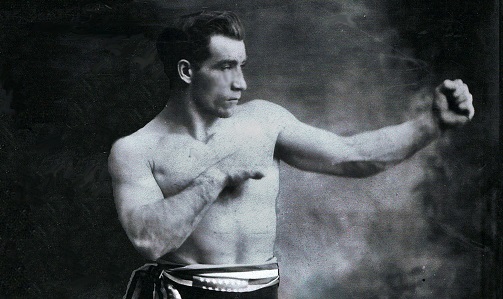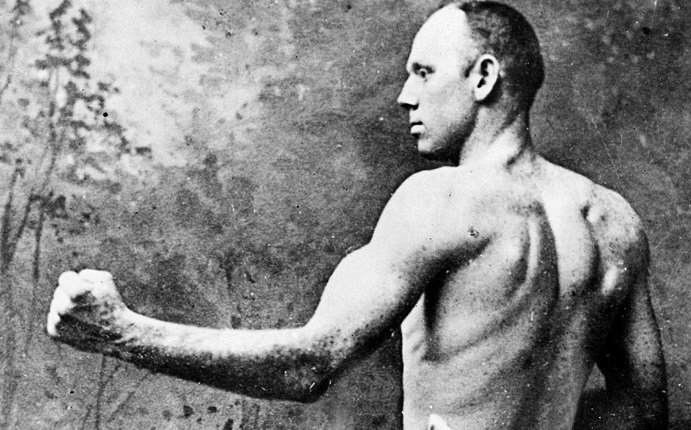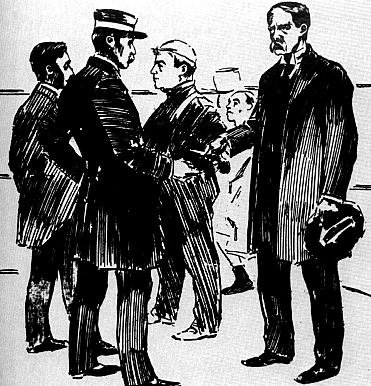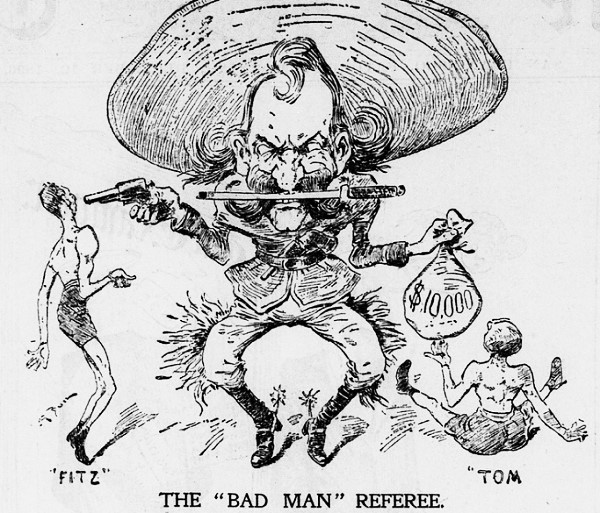Anybody conversant in American fashionable tradition has heard the identify Wyatt Earp and followers of the film Tombstone might imagine they know all concerning the man. However there’s one a part of Earp’s biography that has light from public consciousness, that being his position as a controversial boxing referee. Even these conversant in Earp most likely don’t know he refereed skilled fights, for he’s best-known now as a gunfighter and lawman of the Outdated West, and numerous tales have been penned and movement photos produced showcasing Earp’s position within the notorious “Gunfight on the OK Corral.” However when he died in 1929 on the age of eighty, Earp was maybe most remembered not for being a quick draw, however for being a referee who helped repair a serious heavyweight struggle.
The yr was 1896. Then 48, Earp had given up gun preventing, although he had cashed in on his infamy by writing a number of articles for Hearst publications about his Outdated West exploits. He additionally had a repute as one thing of a small-scale boxing official, having boxed as a teen and refereed fights in each America and Mexico, principally bouts at railroad or buffalo-hunting camps. However out of nowhere he bought the possibility to supervise a serious, high-stakes battle between two of the most effective within the recreation.
Battle legends Bob Fitzsimmons and Tom Sharkey have been set to throw down at Mechanics’ Pavilion in San Francisco. This was no small-time affair, no buffalo-hunting camp struggle, however a big-league showdown that introduced with it main consideration, simply as premiere fights do as we speak. Former champion James “Gentleman Jim” Corbett had just lately retired (although he could be again quickly sufficient) and a brand new prime heavyweight was wanted to fill the void. Boxing was unlawful in San Francisco, however that didn’t matter. Some ten thousand followers crammed the world with everybody who was anybody paying the steep ticket value of ten bucks to see this historic scrap stay and in-person. And the person accountable for the motion was to be Wyatt Earp.

The Nationwide Athletic Membership, the pressure behind the occasion, requested Earp to referee and Wyatt reportedly refused at first. The struggle was being promoted as for the heavyweight championship of the world (a controversial proclamation, as boxing was politicized again then, as it’s as we speak), and the previous lawman feared he may not be as much as the problem on account of his restricted expertise. However such a glittering provide was exhausting to refuse and so Earp walked into the ring on December 2, 1896 to referee a excessive profile bout. However not everybody was completely happy about it.
Controversy erupted even earlier than the opening bell with a couple of particular person warning Fitzsimmons and his camp that Earp had agreed to throw the struggle to Sharkey. This prompted “Ruby’s” supervisor, Martin Julian, to enter the ring earlier than the beginning of the competition and, citing all of the chatter of a repair, demand that somebody exchange Earp as referee. At this level Wyatt provided to withdraw however Sharkey’s crew insisted that he was the person for the job and they might not again down.
However that wasn’t the one notable pre-fight growth. Police captain George Whitman didn’t appear to thoughts an unlawful struggle taking place in San Francisco, however he did thoughts the truth that Earp had entered the ring with a revolver bulging from inside his coat. Wyatt calmly handed over his weapon earlier than the match bought underway.

The bout itself was reportedly enjoying out as many had anticipated it to, with the shrewd technique and thunderous energy of Fitzsimmons, aka “The Combating Blacksmith,” getting the higher of Sharkey’s aggressiveness and brute energy. A intelligent tactician and a devastating puncher who had knocked out the esteemed Peter Maher in a single spherical earlier that yr, “Ruby” was taking Sharkey to high school. However in spherical eight he threw a physique shot which despatched Sharkey to the ground. There “Sailor Tom” writhed and held his groin. Sharkey’s crew instantly argued their fighter was the sufferer of a low blow, whereas Fitzsimmons discovered the entire affair amusing. That’s, till Earp declared Sharkey the winner, through disqualification.

To say the group went wild seems to be an understatement. However the 1000’s at Mechanics’ Pavillion that evening have been shocked not solely by the struggle, however by the choice of the referee, Wyatt Earp. Evidently, it was not an incident that was simply forgotten. The media was throughout it, and Earp was smeared as being in on a repair that assured Sharkey was victorious. A New York Herald artist even drew a likeness of Earp that was past unflattering, with a cartoon cowboy carrying an over-sized sombrero pointing a gun at Fitzsimmons whereas handing a bag of money to Sharkey. Definitely not the stuff of a Hollywood film.
Nobody can rightly say whether or not Earp fastened the struggle, made the best name, or was merely an unwitting participant in a world-class rip-off. The truth that Sharkey wouldn’t be seen by a physician till the day after the struggle solely makes issues extra suspicious. Nonetheless, one didn’t essentially have to pay Earp off with a view to benefit from his providers. Once more, the person was most definitely not certified to ref a struggle at such a excessive degree. What’s extra, there’s the inconvenient incontrovertible fact that Earp had provided to give up his duties to another person earlier than the struggle ever began.

For his half, Earp defended his actions as being completely legit. “I felt I did what was proper … and feeling so, I care nothing for the opinion of anyone,” he instructed The Examiner. “I noticed the foul blow struck as plainly as I see you, and that’s all there may be to it.”
Sadly for Earp, the controversy and smears lasted till after his demise. It took many years for that chaotic night to depart the general public consciousness and for the picture of the towering western determine we all know as we speak to emerge, free from the whiff of ring scandal. — Sean Crose






















